Preprint
Article
A New Hyperchaotic Image Encryption Scheme Based on DNA Computing and SHA-512
This is a preprint, it has not been peer-reviewed.
Submitted:
28 August 2024
Posted:
30 August 2024
You are already at the latest version
Abstract
With the fast growth of smartphones and digital cameras, massive images are generated every day in the world. They are easily transmitted on the insecure channel-Internet. It has been a hot spot for protecting sensitive images during communication. A new cryptosystem is proposed using a six dimensional (6D) hyperchaotic system and DNA computing. The hash value is obtained with the function of SHA-512. It keeps the encrypted result closely connected with the original image. The initial values of the cryptosystem are produced with the hash value and the secret key. The pixel is divided into four parts, and a large matrix is formed. Scrambling is performed on the new image. DNA coding, modern DNA complementary rules, DNA computing, and DNA decoding are performed on the new image. Diffusion is also executed, and ciphered image is achieved finally. The experimental result reveals the outcome of the proposed algorithm. Security analysis shows that the designed algorithm has a huge secret key space, low correlation, and high sensitivity. It also signifies that the designed algorithm could protect against common attacks and is more secure than some existing methods.
Keywords:
-
1. Introduction
With the rapid growth of smartphones and digital cameras, massive images are generated every day in the world. They are easily transmitted on the Internet, which is an insecure channel. It is extremely important to protect sensitive images from hacker attacks during communication. Steganographic algorithms [1-2], watermarking techniques [3-5], and encryption methods [6-10] are three important techniques in terms of protecting private images. Images are famous for special characteristics: data redundancy, high correlation, large storage space, and uneven energy distributions.Traditional text-based encryption algorithms could not be used to encrypt the image, such as AES [11], DES [12], and RSA [13].
Chaos has some special merits: ergodicity, pseudo randomness, and sensibility to initial states. It is widely applied for image encryption [14-20]. Many encryption schemes have been proven to be insufficiently secure and have been cracked [21-28]. The hyperchaotic system has some special characteristics. It has more system variables and parameters, more complicated structures, and better dynamic behaviors than the low-dimensional chaotic system. [29, 30]. Huang et al. [9] proposed a chaotic image encryption method that was based on the game of life and plaintext. Two scrambling matrices were constructed to scramble the plain image. A 4D hyperchaotic system and the game of life were employed to diffuse the image. Musanna and Kuma [14] proposed a novel image encryption method based on a fractional order chaotic system. The chaotic sequences were produced with the 3D chaotic system and the Fisher-Yates method. The plain image was segmented into different blocks of the same size. A 3D hyperchaotic system was employed to scramble the image. The generated chaotic sequences were adopted to diffuse the shuffling image. Fisher-Yates was applied to generate a chaotic matrix. Sun and Chen [18] designed a new cryptosystem based on SHA-256 and chaotic theory. Noise-like pixels were randomly inserted into the plaintext image and generated a hash value with SHA-256.The authors proposed a segmented coordinate descent scheme.
DNA molecules have some special characteristics, such as huge storage space, high parallelism, strong adaptability, and low power consumption. The DNA technique is very suitable for encrypting the image [31-36]. Mansoor et al. [31] presented an image encryption scheme based on chaos theory and DNA computing. The plain image was scrambled with the logistic map and the tent map. DNA computing was performed to encrypt the plain image. Chai et al. [35] introduced an image encryption scheme that was based on the DNA technique and the chaotic technique. The hash value was calculated on the basis of the plain image and applied to compute the initial states and system parameters. The DNA matrix was produced with chaotic sequences. A color image encryption method was designed in Ref. [36]. It adopted a hyperchaotic system and DNA computing. Firstly, four chaotic sequences were produced with a 2D hyperchaotic system. Then an image cube was constructed using image blocks. Finally, DNA operations were applied to the plain image.
2. Related Techniques
2.1. Six-Dimensional Hyperchaotic System
In the manuscript the chaotic sequences are produced with hyperchaotic system. The dimension of the system is six. It is defined as [37]:
where,,,, andare the system parameters.
Its Lyapunov exponents (LE) are 1.4620, 0.1433, 0.0725, 0.0449, 0 and -12.0700 if (,,,,) = (10,76,3,0.2,0.1) . There are four positive LEs in system (1), and it is a hyperchaotic system. The bifurcation diagram of system (1) is shown as Figure 1.
2.2. DNA Coding Rules
There are four nucleic acid bases in a DNA sequence. They are C (cytosine), A (adenine), T (thymine), and G (guanine). Watson and Crick proposed the DNA pairing rules [32]. A and C are complementary to T and G. Two binaries11, 10, 01 and 00 can be adopted to encode four bases. There are eight DNA coding rules, which are presented in Table 1. These coding rules could be used to encode and decode DNA sequences.
Suppose a pixel value is 156 and its binary is 10011100. If the encoding and decoding rules are 3 and 7 respectively, then the encoding and decoding results are shown in Figure 2.
2.3. Modern Dna Complementary Rules
The modern DNA complementary rules are satisfied as [33]:

where W(y) represents a base pair of y and is different from y.
Six modern DNA complementary rules are displayed [35]:
Rule 1. T→A , A→G , G→C , C→T
Rule 2. T→A , A→C , C→G , G→T
Rule 3. T→C , C→A , A→G , G→T
Rule 4. T→C , C→G , G→A , A→T
Rule 5. T→G , G→A , A→C , C→T
Rule 6. T→G , G→C , C→A , A→T
2.4. DNA Computing
Some algebraic and biology operations are proposed for DNA computing. There are DNA addition operation, DNA subtraction operation, and DNA XOR operation. Due to the existence of eight DNA coding rules, there are eight DNA addition, DNA subtraction, and DNA XOR rules. They are shown respectively in Table 2, Table 3 and Table 4.
3. Generation of Chaotic Sequences
The plain image with size M × N is computed with SHA-512, and the hash value W with 512-bit is generated. If an image is changed one bit and a new image is generated, then they will produce totally different hash values [38]. The initial states of system (1) are calculated using secret keys and the hash value W. W is split into many 8-bit data blocks. Each one is changed into a decimal number and is represented as w1, w2, …, w64 .
The initial values will be achieved as follows:
where ski is the secret key, i{1, 2, 3, 4, 5, 6}; j{2, 3, 4, 5, 6}.
2. First iterate system (1) 600 times.
3. Continue to perform 4MN iterations.
4. New sequences z1, z2, z3, z4, z5, z6 and z7 are achieved.
where j=1, 2, …, 4MN; abs means an absolute function; mod symbols a modulus function; floor(z) receives an integer equal to or less than z.
4. Generation of Chaotic Sequences
1. Divide the plain image with an 8-bit pixel into four 2-bit parts. It becomes a new image P1 with size M × 4N. P1(i, j){0, 1, 2, 3}, 1≤ i ≤M and 1≤ j ≤4N.
2. Exchange pixel P1(i, j) with pixel P1(i′, j′).
where 1≤ i ≤M and 1≤ j ≤4N.
3. Convert the matrix P1 into a binary sequence Q= [Q(1), Q(2), …,Q(4MN)].
4. Encode binary sequences Q and z3 into DNA sequences U and z3 according to the chaotic sequence z2.
5. Modern DNA complementary rules are performed on the DNA sequence U.
where i = 1, 2, …, 4MN.
6. DNA computation is executed on the DNA sequences G and z3. The sequence H is decided by the chaotic sequence z5.
where j = 1, 2, …, 4MN.
Decode the DNA sequence H into binary sequences J and convert J to the decimal sequence K.
Diffuse the sequence K and obtain the sequence C.
Sequence C is converted into matrix D and finally the encrypted image is obtained.
The procedure of the presented scheme is briefly described in Figure 3.
The decryption method is the opposite of the encryption procedure. It is not discussed in detail.
5. Simulation Results
6. Security Test
6.1. Key Space Test
If the key space of an encryption scheme is more than 2100, then it will be able to withstand exhaustive attacks [38]. In this manuscript, the secret key is composed of the hash value W and the given values ski, i=1, 2, …, 6. Supposing the computation accuracy of 10-15 [39], the key space is almost 2256×(1015)6 ≈ 2256×2299 = 2555. It is far more than 2100 and the designed algorithm could withstand exhaustive attack.
6.2. Histogram Test
The theoretical histogram of an encrypted image is flat and noise-like. Attackers could not find anything from the histogram. Figure 5 shows the uniform and flat pixel value distribution in encrypted image. It represents that the proposed algorithm could withstand count attack. The Chi square distribution [40] is usually used for histogram analysis. It is defined as:
where Fl is the rate of the gray level l.
If the confidence level is set as 0.05 and the value of is less than(255) =293.25 [41], then the distribution of the histogram will be very consistent. The result of the Chi square distribution is shown in Table 5.
From Table 5, it reveals that four images can pass the Chi-square examination. Therefore, the histogram distribution of the encrypted image is different from that of the plain image. The designed algorithm is capable of resisting the histogram analysis attack.
6.3. Key Sensitive Test
Key sensitive test plays an important role in security analysis. The hash value W is produced with a plain image. Since the initial conditions of the cryptosystem are generated with hash value and secret keys, the encrypted result is tightly connected with the original image. The Baboon image is used to display the simulation performances. A bit is changed in W and forms a new W1.
One of the keys is marginally revised (γ=10-15) and the other keys remain the same. The new key is applied to encrypt and decrypt the image
From Figs. 6 and 7, it shows that even if there is a tiny discrepancy between two images or secret keys, the obtained results will be diverse. The discrepancy of the encrypted images C1 and C2 is about 99.6%. Figure 8 reveals that the incorrect key could not correctly decrypt the image. It proves that the proposed scheme could withstand sensitive analysis.
Figure 6.
Sensitive analysis to the hash value in the encryption process: (a) plain image, (b) encrypted image C1, (c) encrypted image C2, (d) |C1-C2|, (e) - (h) are the corresponding histograms of (a) - (d).
Figure 6.
Sensitive analysis to the hash value in the encryption process: (a) plain image, (b) encrypted image C1, (c) encrypted image C2, (d) |C1-C2|, (e) - (h) are the corresponding histograms of (a) - (d).
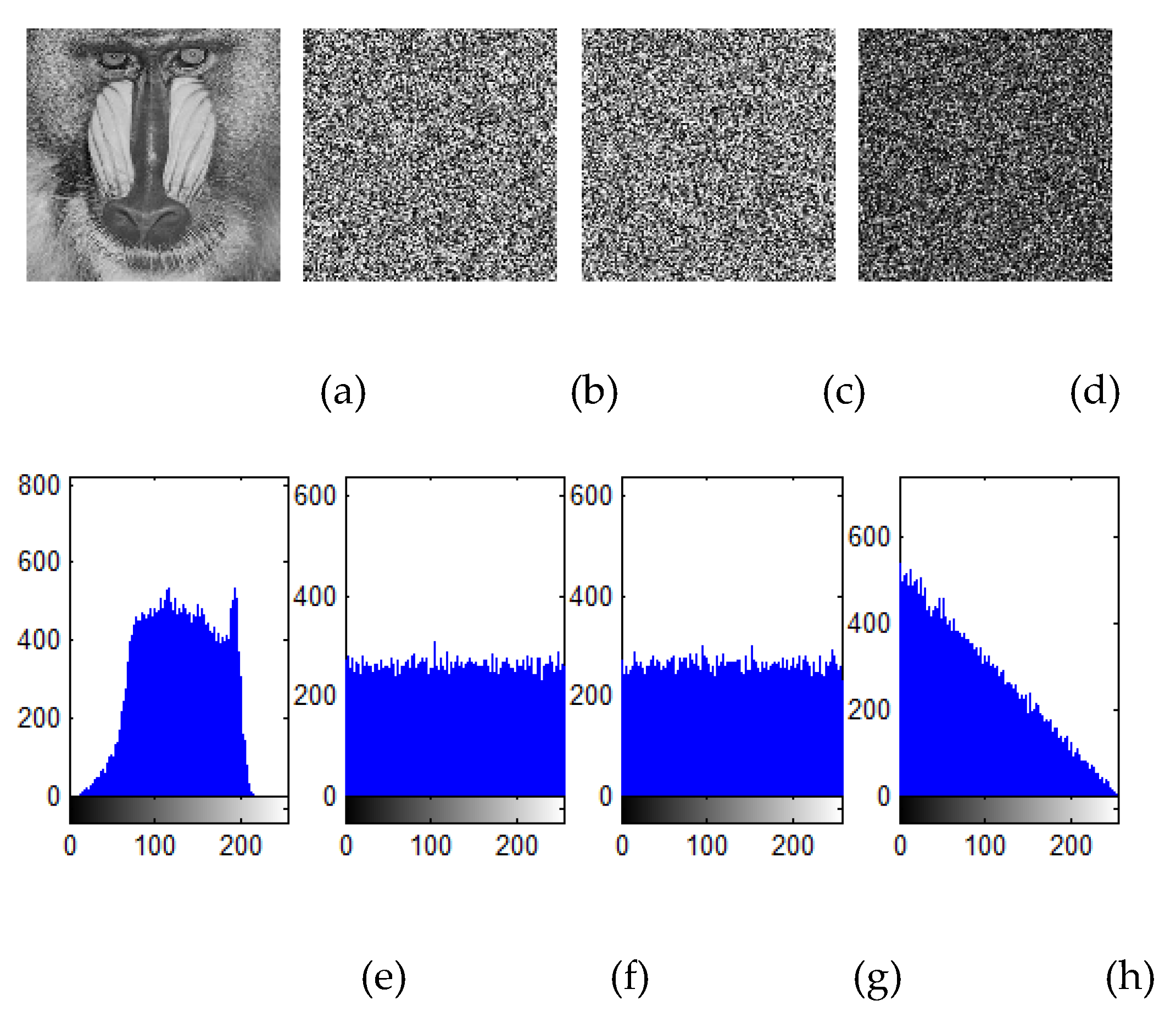
Figure 7.
Sensitive analysis of the keys (γ=10-15) in the encryption procedure: (a) |Enc(sk1+γ)-C1|, (b) |Enc(sk3-γ)-C1|; (c) |Enc(sk5+γ)-C1|, (d) |Enc(sk6-γ)-C1|.
Figure 7.
Sensitive analysis of the keys (γ=10-15) in the encryption procedure: (a) |Enc(sk1+γ)-C1|, (b) |Enc(sk3-γ)-C1|; (c) |Enc(sk5+γ)-C1|, (d) |Enc(sk6-γ)-C1|.
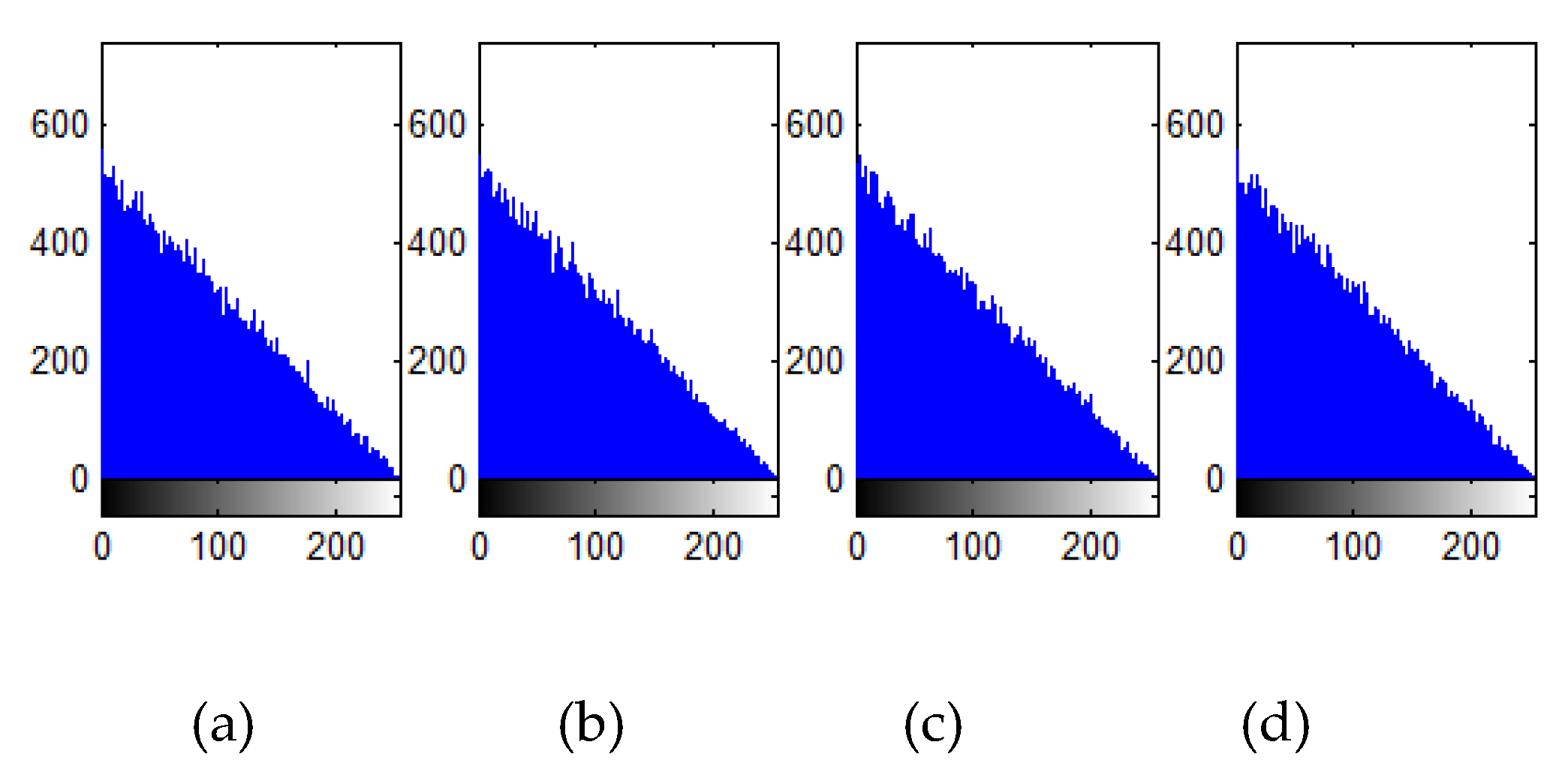
Figure 8.
Sensitive analysis of secret keys (γ=10-15) in the decryption procedure: (a) encrypted image C1, (b) the right decrypted result, (c) |Dec(C1, sk1-γ)|, (d) |Dec(C1, sk3+γ)|.
Figure 8.
Sensitive analysis of secret keys (γ=10-15) in the decryption procedure: (a) encrypted image C1, (b) the right decrypted result, (c) |Dec(C1, sk1-γ)|, (d) |Dec(C1, sk3+γ)|.
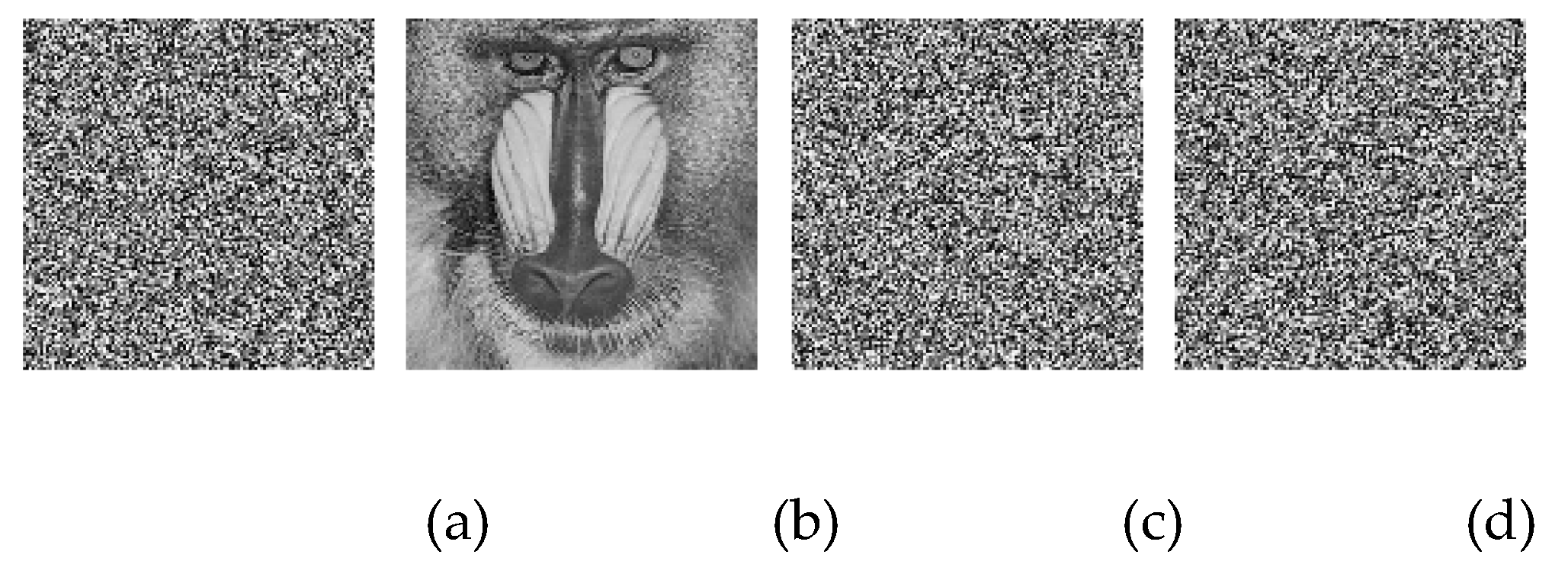
6.4. Correlation Test
The correlation coefficient (CR) can be defined as [35]:
where Ai and Bi represents the adjacent pixel; L is the total number of pixels.
Some neighboring pixel pairs are randomly chosen to compute the CR values in vertical (V), horizontal (H), and diagonal (D) directions. Figure 9 illustrates the correlation of adjacent pixels in the Baboon image and the corresponding encrypted image. Table 6 shows the CR values in three directions, and Table 7 presents comparisons of the CR values using different algorithms.
6.5. Shannon Entropy Test
The global Shannon entropy (GSE) is often applied to test randomness. It can be computed as follows:
where nj means the j-th information source; p(nj) symbolises the probability of nj. For an 8-bit grayscale image, the theoretical value of GSE is 8.
The local Shannon entropy (LSE) is proposed by Wu et al. [46] and adopted to measure randomness from a local perspective. It is calculated as
where Bi is a randomly chosen and non-overlapped data block. There are L pixels in each block. In this paper, (r, L) is appointed to (30,1936). If the LSE value lies within the interval [,], then the proposed algorithm will pass the Shannon entropy test [15]. The GSE and LSE values are organized in Table 8.
Table 8 indicates that the average value of GSE is about 7.9971. Most LSE values could pass three kinds of tests. It reveals that the designed scheme effectively resists Shannon entropy analysis.
6.6. Differential Attack Test
UACI and NPCR are often used for the differential attack test [34].
where E1 and E2 are two encrypted images.
6.7. Encryption Quality Test
ID and DUH can be used to measure encryption image quality [8]. Encryption quality will be much better if the values of ID and DUH are smaller. They can be obtained as [47]:
where HC and HP represent the histograms of encrypted image C and plain image P.
The DUH and ID values are listed in Table 10. It shows that the designed method produces smaller values of two indicators than the existing schemes. It reveals that the proposed algorithm has high encryption quality.
6.8. Texture Test
Homogeneity, contrast, and energy are three indexes which are used for texture test [8]. They are defined as follows:
where GLCM(u, v) means the gray-level co-occurrence matrix.
The lower values of homogeneity and energy denote a higher security, and the higher value of contrast will be much better.
Three values are listed in Table 11.
As shown in Table 11, the designed algorithm performs well. It proves that the proposed method will be able to withstand the texture test.
6.9. Robustness Test
6.9.1. Cropping attack test
Images may be subject to noise or data loss attacks during transmission. Robustness reflects the ability of a scheme to resist interference. The encrypted image of Baboon is cropped 3.125%, 6.25%, 12.5%, and 25% data. The decrypted results are shown in Figure 10.
Figure 10 shows that even if there is a lot of noise in the decrypted result, it is still identifiable. It reveals that the designed algorithm passes the cropping attack test.
6.9.2. Noise attack test
The encrypted image of Baboon is suffered from noise attack. The densities of salt & pepper noise are 0.5%, 2%, 10%, and 30%. Figure11 shows the decrypted images. It means that the recovered images are able to be recognized. It symbolises that the proposed scheme is robust enough to pass noise attack test.
Figure 11.
Robustness against noise attack: (a)-(d) are the decrypted images with 0.5%, 2%, 10%, and 30% noise.
Figure 11.
Robustness against noise attack: (a)-(d) are the decrypted images with 0.5%, 2%, 10%, and 30% noise.
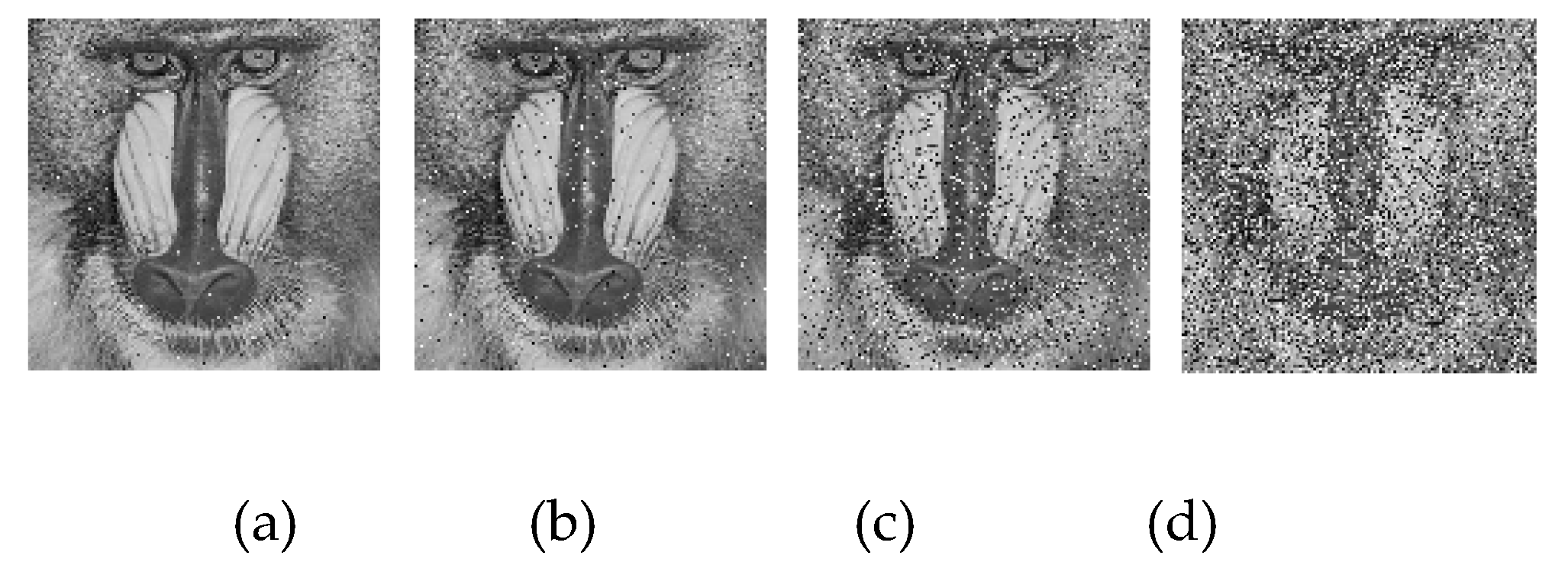
7. Discussion
In the manuscript a novel hyperchaotic image encryption scheme is proposed. Chaotic sequences are generated with 6D chaotic systems. The encrypted result is closely related to the plain image with SHA-512. The initial values are produced with a hash value and a secret key. Each pixel is divided into four equal segments. Permutation is performed based on chaotic sequences. DNA coding, modern DNA complementary rules, DNA computing and DNA decoding are executed on the new image with size M × 4N. The image is performed on diffusion operation, and encrypted image is achieved finally. The experimental results display the effects of the proposed scheme. Secure test shows that the designed method possesses a huge key space, low pixel correlation, high encryption quality, and sensitivity. It also concludes that the designed algorithm could resist common attacks and is much better than some existing methods.
Author Contributions
Conceptualization, S.S. and X.W.; methodology, S.S.; software, S.S.; validation, S.S. and X.W.; formal analysis, S.S.; investigation, S.S.; data curation, S.S.; writing—original draft preparation, S.S.; writing—review and editing, X.W.; funding acquisition, S.S and X.W. All authors have read and agreed to the published version of the manuscript.
Funding
This research was funded by the Natural Science Foundation of Hunan Province of China, grant number 2024JJ7310, 2024JJ7317 and the Startup Project for Doctorate Scientific Research of Hunan University of Arts and Science of China grant number 22BSQD07, 22BSQD32.
Data Availability Statement
No new data were created or analyzed in this study. Data sharing is not applicable to this article.
Conflicts of Interest
The authors declare no conflicts of interest.
References
- Zhang X.; Wang S. Steganography using multiple-base notational system and human vision sensitivity. IEEE Signal Proc. Let. 2004, 12, 67-70. [CrossRef]
- Dash S.; Behera D. K.; Swetanisha S.; Das M. High payload image steganography using DNN classification and adaptive difference expansion. Wireless Pers. Commun. 2024, 134,1349-1366. [CrossRef]
- Qiao L.; Nahrstedt K. Watermarking schemes and protocols for protecting rightful ownership and customer's rights. J. Vis. Commun. Image R. 1998, 9, 194-210. [CrossRef]
- Wu S.; Huang J.; Huang D.; Shi Y. Efficiently self-synchronized audio watermarking for assured audio data transmission. IEEE T. Broadcast. 2005, 51, 69-76. [CrossRef]
- Fernandez J. J.; Nithyanandam P. Protection of online images against theft using robust multimodal biometric watermarking and T-norms. Multimed. Tools Appl. 2024, 83, 52405-52431. [CrossRef]
- Gao Z. A new chaotic system. J. Hunan Uni. Art. Sci. 2011, 23, 34-47.
- Sun S.; Guo Y. A new hyperchaotic image encryption algorithm based on stochastic signals. IEEE Access 2021, 9, 144035- 144045. [CrossRef]
- Sun S. A new image encryption scheme based on 6D hyperchaotic system and random signal insertion. IEEE Access 2023, 11, 66009- 66016. [CrossRef]
- Huang H.; Chen Y.; Chen D. Plaintext-related image encryption scheme based on chaos and game of life. J. Electron. Imaging 2022, 31, 013031. [CrossRef]
- Hosny K. M.; Kamal S. T.; Darwish M. M.; Papakostas G. A. New image encryption algorithm using hyperchaotic system and fibonacci q-matrix. Electronics 2021,10, 1066. [CrossRef]
- Czapski M.; Nikodem M. Error detection and error correction procedures for the advanced encryption standard. Design. Code. Cryptogr. 2008, 49, 217-232. [CrossRef]
- Orceyre M.; Heller R. An approach to secure voice communication based on the data encryption standard. IEEE Commun. Society Mag. 1978, 16, 41-50. [CrossRef]
- Rahman M. M.; Sana T. K.; Bhuiyan A. A. Implementation of RSA algorithm for speech data encryption and decryption. Int. J. Comput. Sci. Net. 2012, 12, 74-82.
- Musanna F.; Kumar S. A novel fractional order chaos-based image encryption using Fisher Yates algorithm and 3-D cat map. Multimed. Tools Appl. 2019, 78, 14867-14895. [CrossRef]
- Wang X.; Liu C.; Jiang D. A novel visually meaningful image encryption algorithm based on parallel compressive sensing and adaptive embedding. Expert Syst. Appl. 2022, 209, 118426. [CrossRef]
- Lai Q.; Hu G.; Erkan U.; Toktas A. A novel pixel-split image encryption scheme based on 2D Salomon map. Expert Syst. Appl. 2023, 213, 118845. [CrossRef]
- Alawida M.; A. Samsudin A.; The J. S.; Alkhawaldeh R. S. A new hybrid digital chaotic system with applications in image encryption. Signal Process. 2019, 160, 45-58. [CrossRef]
- Sun X.; Chen Z. Novel chaotic image encryption algorithm based on coordinate descent and SHA-256. IEEE Access 2022, 10, 114597-114611. [CrossRef]
- Shukur A. A.; AlFallooji M. A.; Pham V. T. Asymmetrical novel hyperchaotic system with two exponential functions and an application to image encryption. Nonlinear Eng. 2024, 13, 1-12. [CrossRef]
- Zareimani E.; Parvaz R. Secure multiple-image transfer by hybrid chaos system: encryption and visually meaningful images. Mathematics 2024, 12, 1176. [CrossRef]
- Wang X.; Teng L.; Qin X. A novel colour image encryption algorithm based on chaos. Signal Process. 2012, 92, 1101-1108. [CrossRef]
- Li C.; Zhang L.; Rong O.; Wong K. W.; Shi S. Breaking a novel colour image encryption algorithm based on chaos. Nonlinear Dynam. 2012, 70, 2383-2388. [CrossRef]
- Liu Z.; Pun C. Reversible data-hiding in encrypted images by redundant space transfer. Inform. Sciences 2018, 433, 188-203. [CrossRef]
- Xiang Y.; Xiao D.; Zhang R.; Liang J.; Liu R. Cryptanalysis and improvement of a reversible data-hiding scheme in encrypted images by redundant space transfer. Inform. Sciences 2021, 545, 188-206. [CrossRef]
- Wu X.; Zhu B.; Hu Y.; Ran Y. A novel color image encryption scheme using rectangular transform-enhanced chaotic tent maps. IEEE Access 2017, 5, 6429-6436. [CrossRef]
- Zhu C.; Sun K. Cryptanalyzing and improving a novel color image encryption algorithm using RT-enhanced chaotic Tent maps. IEEE Access 2018, 6, 18759-18770. [CrossRef]
- Anwar S.; Meghana S. A pixel permutation based image encryption technique using chaotic map. Multimed. Tools Appl. 2019, 78, 27569-27590. [CrossRef]
- Mokhnache A.; Ziet L. Cryptanalysis of a pixel permutation based image encryption technique using chaotic map. Trait. Signal 2020, 37, 95-100. [CrossRef]
- Chen H.; Bai E.; Jiang X.; Wu Y. Fast image encryption algorithm based on improved 6-D hyper-chaotic system. IEEE Access 2022, 10, 116031-116044. [CrossRef]
- Man Z.; Zhang Y.; Zhou Y.; Lu X.; Wang Z. Bit level image encryption algorithm based on hyperchaotic system. Optoelectron. Lett. 2023, 19, 186-192. [CrossRef]
- Mansoor S.; Parah S. A. HAIE: a hybrid adaptive image encryption algorithm using Chaos and DNA computing. Multimed. Tools Appl. 2023, 82, 28769-28796. [CrossRef]
- Watson J. D.; Crick F. H. C. Molecular structure of nucleic acids: a structure for deoxyribose nucleic acid. Nature 1953, 4356, 737-738. [CrossRef]
- Wang X.; Zhang Y.; Bao X. A novel chaotic image encryption scheme using DNA sequence operations. Opt. Laser. Eng. 2015, 73, 53-61. [CrossRef]
- Zhu S.; Deng X.; Zhang W.; Zhu C. Image encryption scheme based on newly designed chaotic map and parallel DNA coding. Mathematics 2023, 11, 231. [CrossRef]
- Chai X.; Gan Z.; Yuan K.; Chen Y.; Liu X. A novel image encryption scheme based on DNA sequence operations and chaotic systems. Neural Comput. Appl. 2019, 31, 219-237. [CrossRef]
- Wang Q.; Zhang X.; Zhao X. Color image encryption algorithm based on novel 2D hyperchaotic system and DNA crossover and mutation. Nonlinear dynam. 2023, 111, 22679-22705. [CrossRef]
- Benkouider K.; Bouden T.; Yalcin M. E.; Vaidyanathan S. A new family of 5D, 6D, 7D and 8D hyperchaotic systems from the 4D hyperchaotic Vaidyanathan system, the dynamic analysis of the 8D hyperchaotic system with six positive Lyapunov exponents and an application to secure communication design. Int. J. Model. Identif. 2022, 35, 241-257.
- Alvarez G.; Li S. Some basic cryptographic requirements for chaos-based cryptosystems. Int. J. Bifurcat. Chaos 2006, 16, 2129-2151. [CrossRef]
- IEEE standard for binary floating-point arithmetic. IEEE Standard 1985, 754.
- Wang J.; Zhang Y.; Wang F.; Ni R.; Hu Y. Color-image encryption scheme based on channel fusion and spherical diffraction. Chines. Phys. B 2022, 31, 034205. [CrossRef]
- Cao C.; Sun K.; Liu W. A novel bit-level image encryption algorithm based on 2D-LICM hyperchaotic map. Signal Process. 2018, 143, 122-133. [CrossRef]
- Biban G.; Chugh R.; Panwar A. Image encryption based on 8D hyperchaotic system using Fibonacci Q-Matrix. Chaos Soliton. Fract. 2023, 170, 113396. [CrossRef]
- Zang H.; Tai M.; Wei X. Image encryption schemes based on a class of uniformly distributed chaotic systems. Mathematics, 2022, 10, 1027. [CrossRef]
- Mathivanan P.; Maran P.; Color image encryption based on novel kolam scrambling and modifed 2D logistic cascade map. J. Supercomput. 2024, 80, 2164-2195. [CrossRef]
- Zhao J.; Zhang T.; Jiang J.; Fang T.; Ma H. Color image encryption scheme based on alternate quantum walk and controlled Rubik’s Cube. Scientifc Rep. 2022, 12, 14253. [CrossRef]
- Wu Y.; Zhou Y.; Saveriades G.; Agaian S.; Noonan J. P.; Natarajan P. Local Shannon entropy measure with statistical tests for image randomness. Inform. Sciences 2013, 222, 323-342. [CrossRef]
- Zhu S.; Zhu C. Plaintext-related image encryption algorithm based on block structure and five-dimensional chaotic map. IEEE Access 2019, 7, 147106-147118. [CrossRef]
- Belazi A.; El-Latif A. A. A.; Belghith S. A novel image encryption scheme based on substitution-permutation network and chaos. Signal Process. 2016, 128, 155-170. [CrossRef]
Figure 1.
The bifurcation diagram of the system (1).
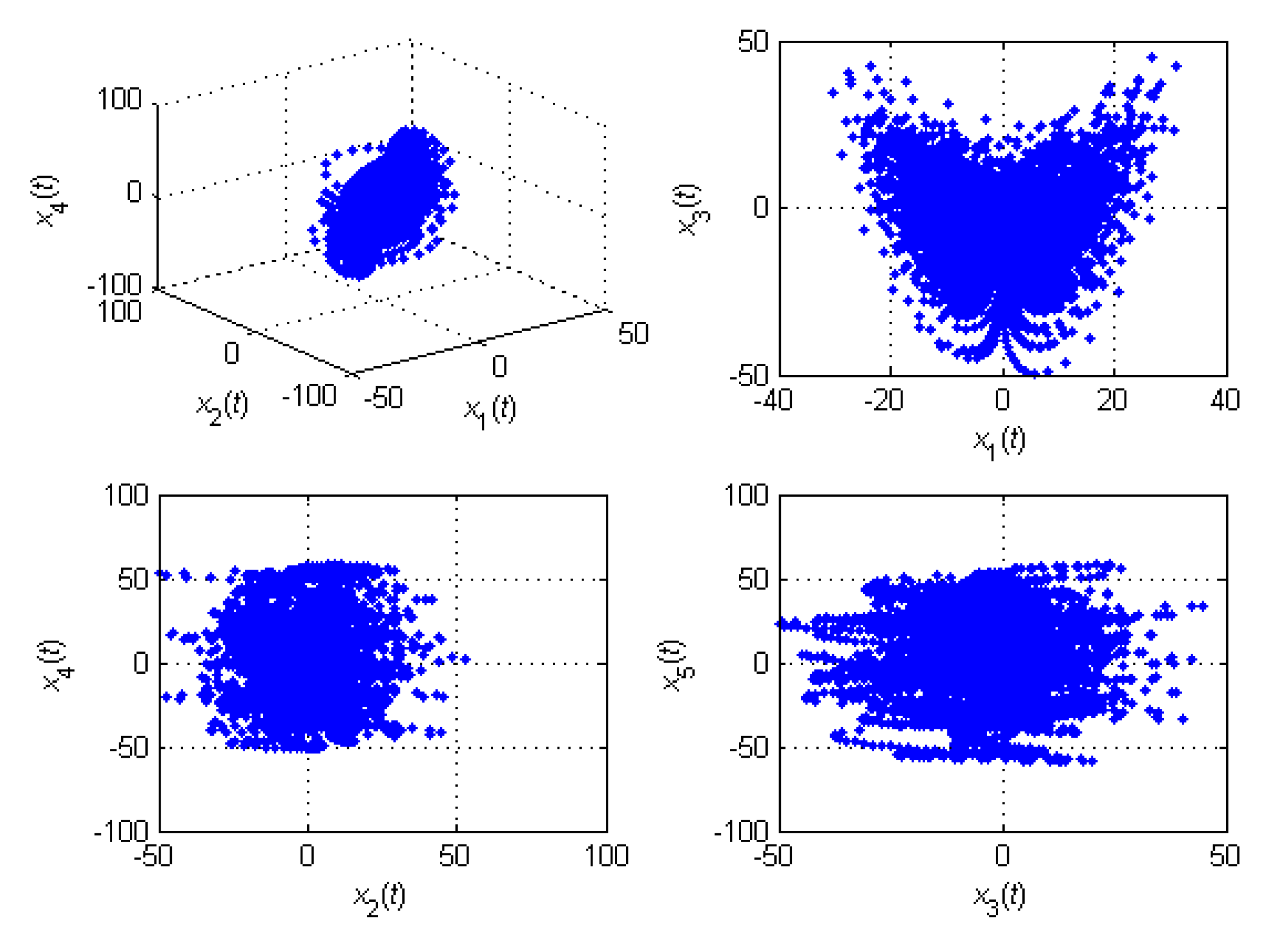
Figure 2.
DNA encoding and decoding results.

Figure 3.
The procedure of the proposed scheme.
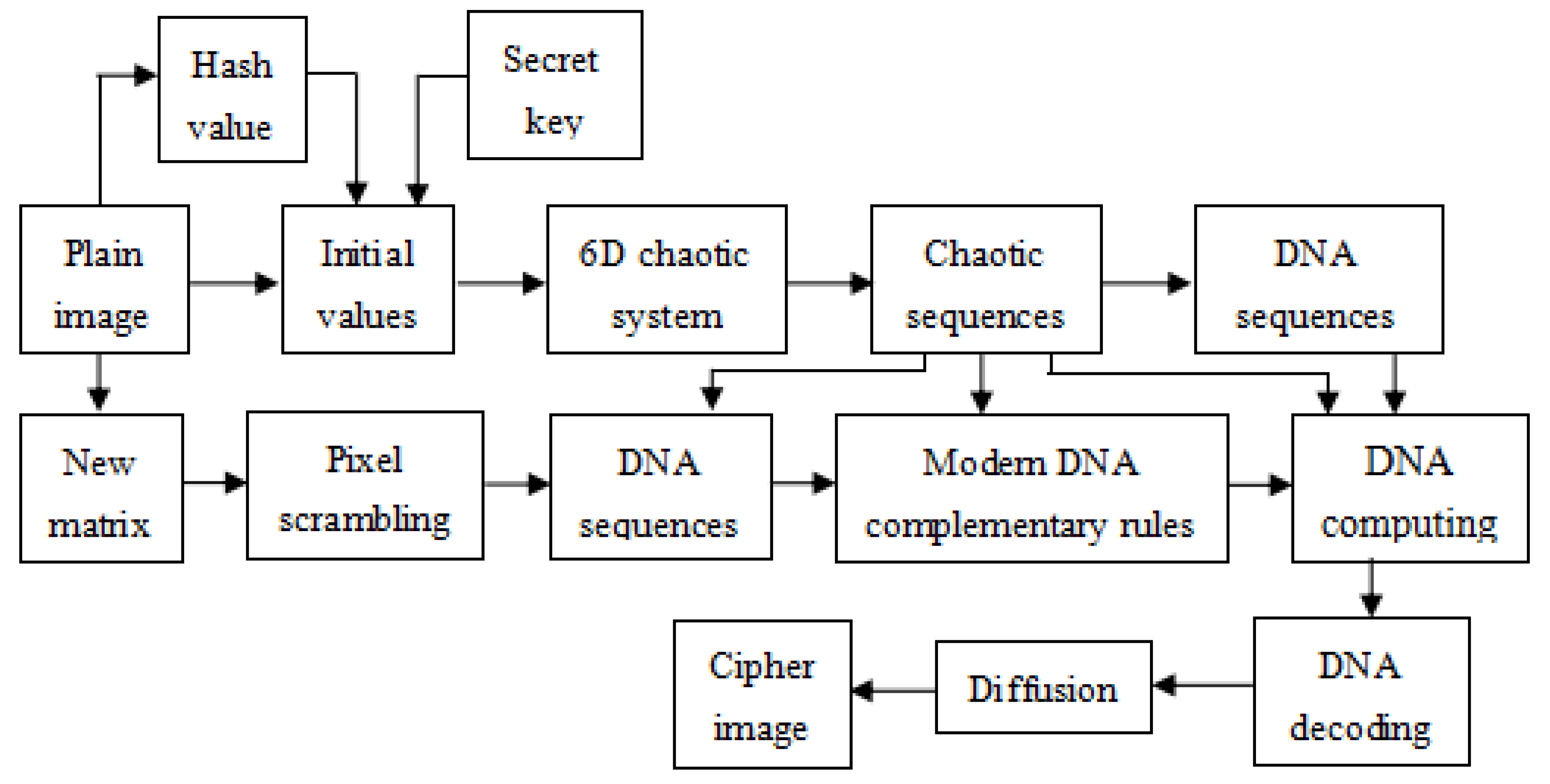
Figure 4.
Simulation results: (a) original image, (b) encrypted image, (c) decrypted image.
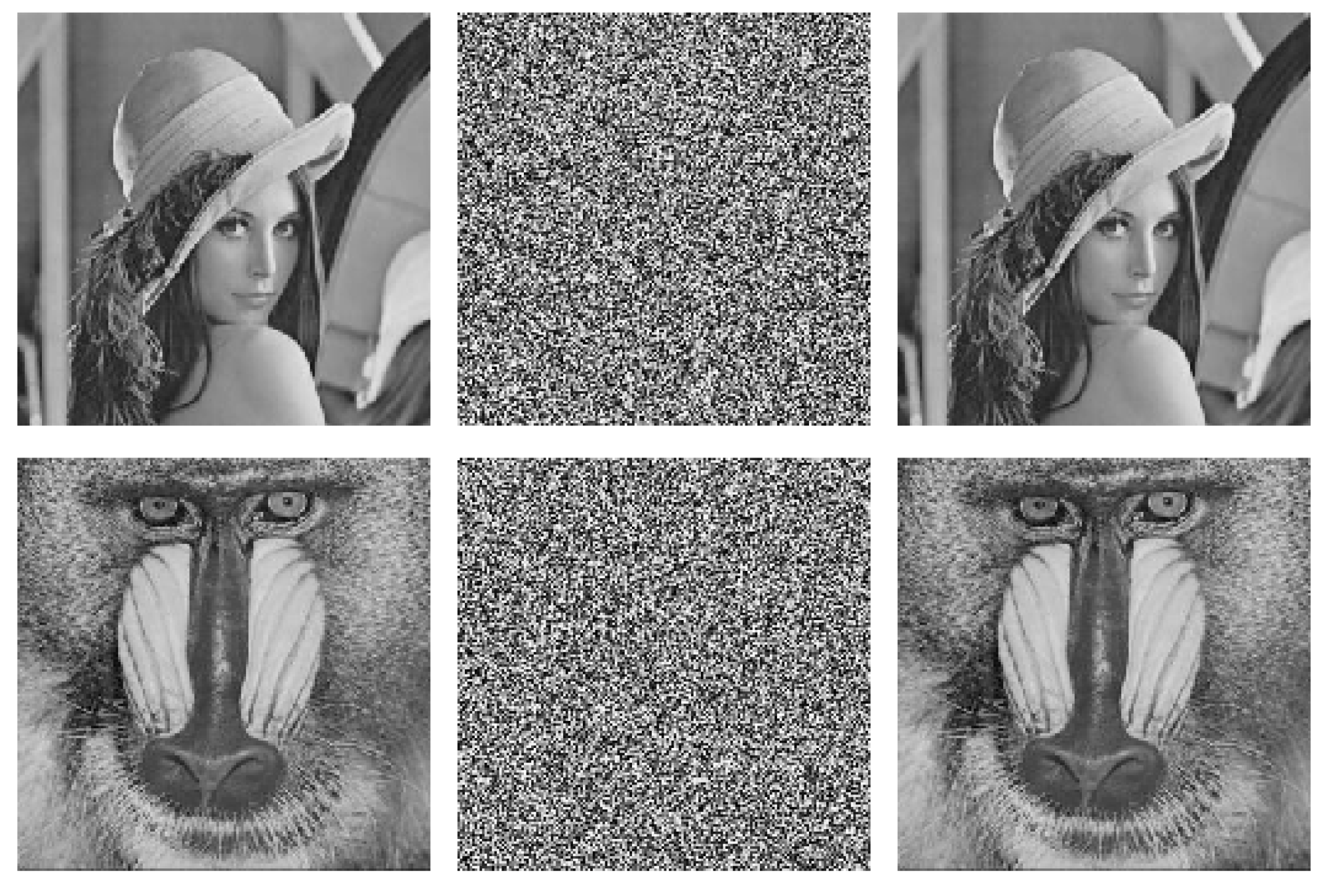
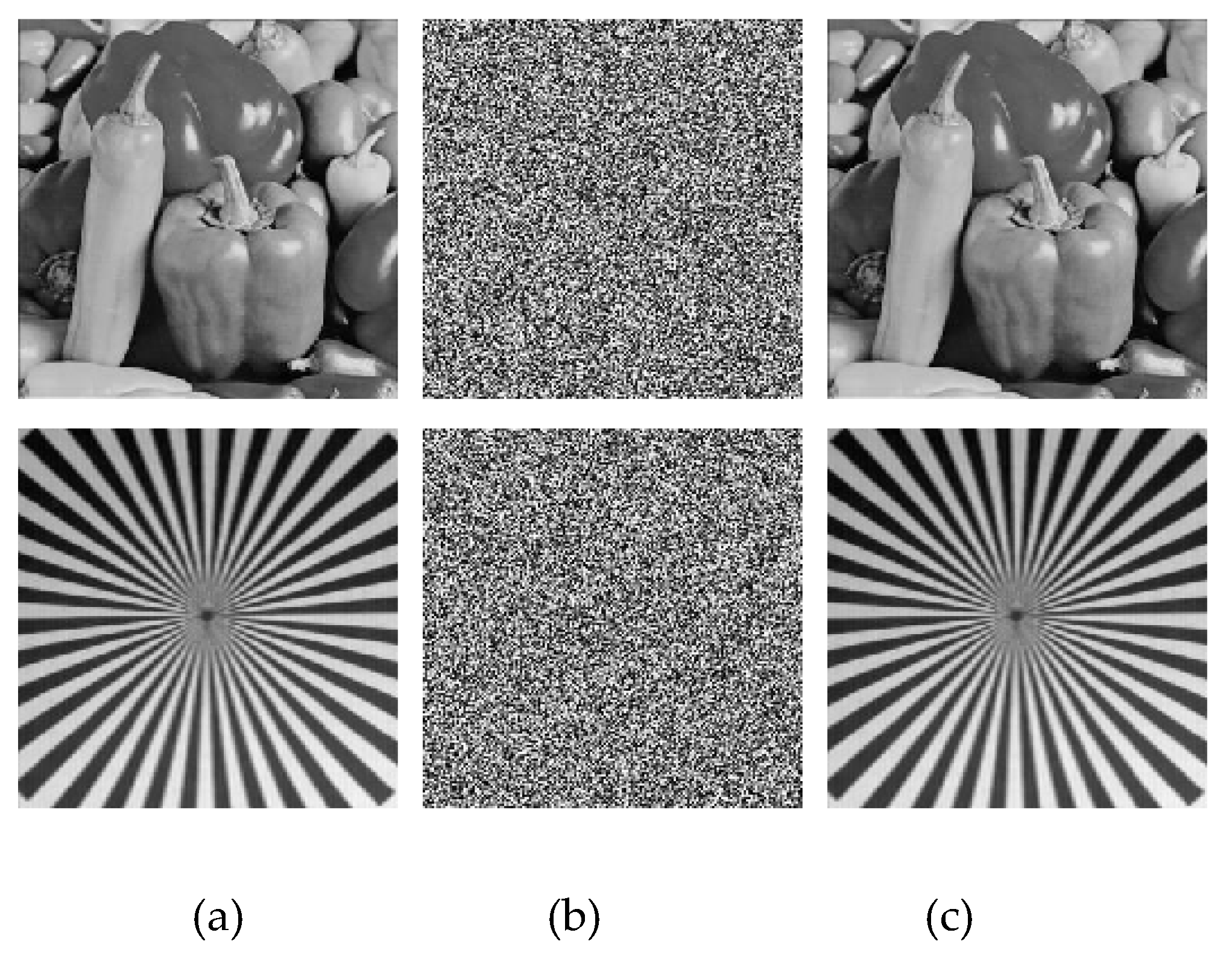
Figure 5.
Histograms of plain, encrypted, and decrypted images: (a) plain, (b) encrypted, (c) decrypted.
Figure 5.
Histograms of plain, encrypted, and decrypted images: (a) plain, (b) encrypted, (c) decrypted.

Figure 9.
Correlation coefficients of Baboon: (a), (c), (e) are vertical, horizontal, and diagonal directions of the plain image, and (b), (d), (f) are three directions of the corresponding encrypted image.
Figure 9.
Correlation coefficients of Baboon: (a), (c), (e) are vertical, horizontal, and diagonal directions of the plain image, and (b), (d), (f) are three directions of the corresponding encrypted image.
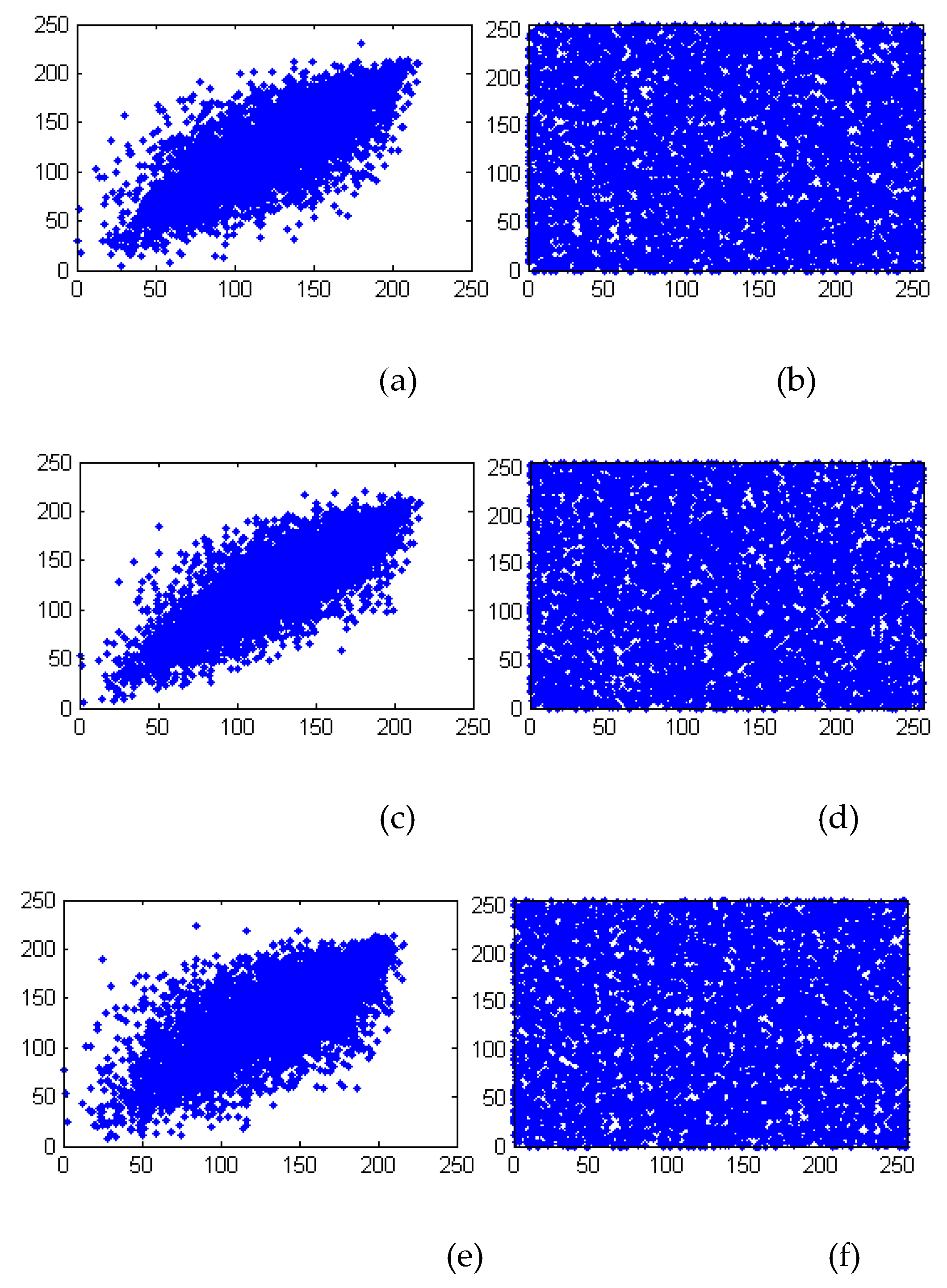
Figure 10.
Robustness against cropping attack: (a)-(d) are the encrypted images with 3.125%, 6.25%, 12.5% and 25% data loss, and (e)-(h) are the decrypted images of (a)-(d). .
Figure 10.
Robustness against cropping attack: (a)-(d) are the encrypted images with 3.125%, 6.25%, 12.5% and 25% data loss, and (e)-(h) are the decrypted images of (a)-(d). .

Table 1.
DNA coding rules.
| Rule | 1 | 2 | 3 | 4 | 5 | 6 | 7 | 8 |
|---|---|---|---|---|---|---|---|---|
| 00 | G | G | T | T | A | A | C | C |
| 01 | A | T | C | G | C | G | A | T |
| 10 | T | A | G | C | G | C | T | A |
| 11 | C | C | A | A | T | T | G | G |
Table 2.
DNA addition rule.
| + | G | T | A | C |
|---|---|---|---|---|
| G | G | T | A | C |
| T | T | A | C | G |
| A | A | C | G | T |
| C | C | G | T | A |
Table 3.
DNA subtraction rule.
| - | G | T | A | C |
| G | G | C | A | T |
| T | T | G | C | A |
| A | A | T | G | C |
| C | C | A | T | G |
Table 4.
DNA addition rule.
| ⊕ | G | T | A | C |
| G | G | T | A | C |
| T | T | G | C | A |
| A | A | C | G | T |
| C | C | A | T | G |
Table 5.
The Chi square distribution.
| Image | Lena | Baboon | Peppers | Testpat |
| 293.25 | 293.25 | 293.25 | 293.25 | |
| 250.04 | 242.55 | 242.14 | 266.71 | |
| Decision | Yes | Yes | Yes | Yes |
Table 6.
Correlation of four encrypted images.
| Image | H | V | D |
| Lena | 0.0018 | 0.0021 | -0.0026 |
| Baboon | 0.0012 | 0.0015 | -0.0008 |
| Peppers | 0.0014 | -0.0029 | -0.0003 |
| Testpat | 0.0036 | 0.0078 | 0.0015 |
Table 7.
Comparisons of CR values.
| Scheme | H | V | D |
| Ref. [10] | 0.0065 | 0.0337 | 0.0244 |
| Ref. [41] | 0.0077 | 0.0013 | 0.0006 |
| Ref. [43] | -0.0122 | -0.0032 | 0.0406 |
| Ref. [44] | 0.0064 | 0.0024 | 0.0043 |
| Ref. [45] | 0.0143 | 0.0103 | 0.0103 |
| Proposed | 0.0012 | 0.0015 | 0.0008 |
Table 8.
Comparisons of CR values.
| Image | GSE | LSE | = 7.9015 | = 7.9017 | =7.9019 |
| = 7.9034 | = 7.9032 | =7.9030 | |||
| 0.001-level | 0.01-level | 0.05-level | |||
| Lena | 7.9975 | 7.9026 | pass | pass | no |
| Baboon | 7.9972 | 7.9028 | pass | pass | pass |
| Peppers | 7.9970 | 7.9021 | pass | pass | pass |
| Testpat | 7.9969 | 7.9018 | pass | pass | no |
Table 9.
Comparisons of CR values.
| Work | Indicator | Lena | Baboon | Peppers | Testpat |
| Proposed | NPCR (%) | 99.61 | 99.60 | 99.62 | 99.63 |
| UACI (%) | 33.45 | 33.44 | 33.45 | 33.49 | |
| Ref. [10] | NPCR (%) | 99.61 | 99.59 | 99.60 | 99.62 |
| UACI (%) | 33.42 | 33.46 | 33.43 | 33.49 | |
| Ref. [44] | NPCR (%) | 99.56 | 99.60 | 99.61 | 99.63 |
| UACI (%) | 33.32 | 33.45 | 33.47 | 33.58 | |
| Ref. [45] | NPCR (%) | 99.60 | 99.62 | 99.61 | 99.57 |
| UACI (%) | 33.45 | 33.44 | 33.45 | 33.40 |
Table 10.
Encryption quality test.
| Work (Peppers) | ID | DUH |
|---|---|---|
| Proposed | 11652 | 0.0493 |
| Ref. [17] | 23863 | 0.0522 |
| Ref. [47] | 28963 | 0.0782 |
| Ref. [48] | 35088 | 0.0917 |
Table 11.
Texture test.
| Image | Homogeneity | Contrast | Energy |
|---|---|---|---|
| Lena | 0.4062 | 10.5312 | 0.0166 |
| Baboon | 0.4053 | 10.5417 | 0.0162 |
| Peppers | 0.4068 | 10.5409 | 0.0158 |
| Testpat | 0.4074 | 10.5138 | 0.0173 |
Disclaimer/Publisher’s Note: The statements, opinions and data contained in all publications are solely those of the individual author(s) and contributor(s) and not of MDPI and/or the editor(s). MDPI and/or the editor(s) disclaim responsibility for any injury to people or property resulting from any ideas, methods, instructions or products referred to in the content. |
© 2024 by the authors. Licensee MDPI, Basel, Switzerland. This article is an open access article distributed under the terms and conditions of the Creative Commons Attribution (CC BY) license (http://creativecommons.org/licenses/by/4.0/).
Copyright: This open access article is published under a Creative Commons CC BY 4.0 license, which permit the free download, distribution, and reuse, provided that the author and preprint are cited in any reuse.
Alerts
MDPI Initiatives
Important Links
© 2024 MDPI (Basel, Switzerland) unless otherwise stated






